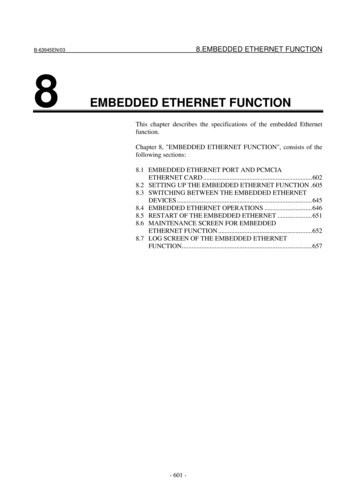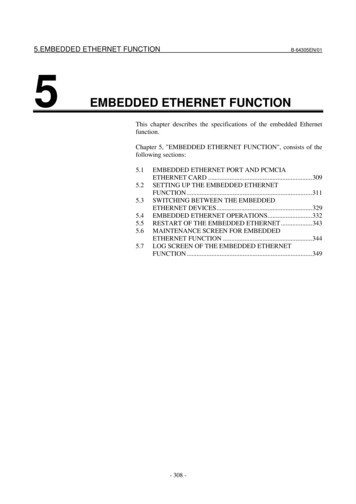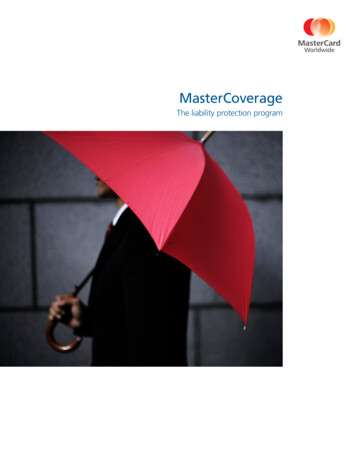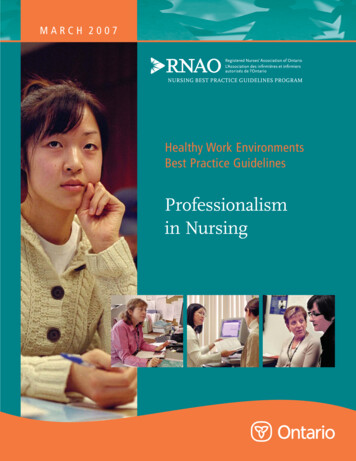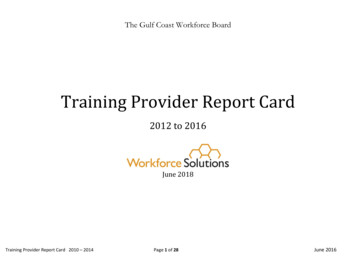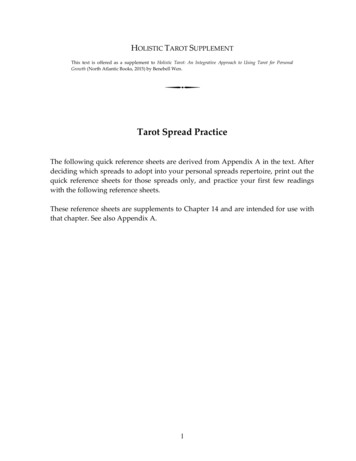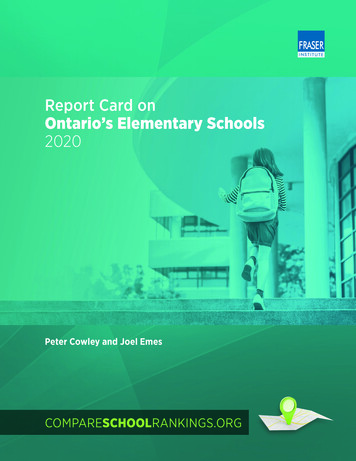
Transcription
FRASERINSTITUTEReport Card onOntario’s Elementary Schools2020Peter Cowley and Joel EmesCOMPARESCHOOLRANKINGS.ORG
Report Card on Ontario’sElementary Schools20203By Peter Cowley and Joel Emes
ContentsIntroduction/3Key academic indicators of school performanceOther indicators of school performanceNotes///589Detailed school reports / 10How does your school stack up?/224Appendix: Calculating the Overall rating out of 10About the authors/Publishing information/253/254Supporting the Fraser Institute /255Purpose, funding, & independence /About the Fraser InstituteEditorial Advisory Board //2552562562251
IntroductionThe Report Card on Ontario’s Elementary Schools 2020(hereafter, Report Card) collects a variety of relevant,objective indicators of school performance into one,easily accessible public document so that anyone cananalyze and compare the performance of individualschools. By doing so, the Report Card assists parentswhen they choose a school for their children andencourages and assists all those seeking to improvetheir schools.picture of each school that is not easily availableelsewhere.The Report Card facilitatesschool improvementThe act of publicly rating and ranking schools attractsattention, and this can provide motivation. Schoolsthat perform well or show consistent improvementare applauded. Poorly performing schools generateconcern, as do those whose performance is deteriorating. This inevitable attention provides an incentivefor all those connected with a school to focus onstudent results.However, the Report Card offers more than justincentive. It includes a variety of indicators, each ofwhich reports results for an aspect of school performance that may be improved. School administratorswho are dedicated to their students’ academic successaccept the Report Card as another source of opportunities for improvement.The Report Cardhelps parents chooseWhere parents can choose among several schools fortheir children, the Report Card provides a valuabletool for making a decision. Because it makes comparisons easy, it alerts parents to those nearby schools thatappear to have more effective academic programs.Parents can also determine whether schools of interestare improving over time. By first studying the ReportCard, parents will be better prepared to ask relevantquestions when they visit schools under considerationand speak with the staff.Of course, the choice of a school should not bemade solely on the basis of a single source of information. Web sites maintained by Ontario’s EducationQuality and Accountability Office (EQAO),1 the provincial ministry of education, and local school boardsmay also provide useful information.2 Parents whoalready have a child enrolled at the school provideanother point of view.Naturally, a sound academic program shouldbe complemented by effective programs in areas ofschool activity not measured by the Report Card.Nevertheless, the Report Card provides a detailedSome schools do better than othersTo improve a school, one must believe that improvement is achievable. This Report Card, like other reportcards from the Fraser Institute, provides evidence aboutwhat can be accomplished. It demonstrates clearly that,even when we take into account factors such as the students’ family income—which some believe dictate thedegree of academic success that students can enjoy inschool—some schools do better than others. This finding confirms the results of research carried out in othercountries.3 Indeed, it will come as no great surprise toexperienced parents and educators that the data consistently suggest that what goes on in the schools makes3
4Report Card on Ontario’s Elementary Schools 2020a difference to academic results and that some schoolsmake a greater difference than others.Comparisons are at the heartof the improvement processBy comparing a school’s latest results with those ofearlier years, we can see if the school is improving.By comparing a school’s results with those of neighbouring schools or schools having similar school andstudent characteristics, we can identify more successful schools and learn from them. Reference to overallprovincial results places an individual school’s level ofachievement in a broader context.There is great benefit in identifying schools thatare particularly effective. By studying the techniquesused in schools where students are successful, lesseffective schools may find ways to improve.Comparisons are at the heart of improvement:making comparisons among schools is made simplerand more meaningful by the Report Card’s indicators,ratings, and rankings.You can contribute to thedevelopment of the Report CardThe Report Card program benefits from the inputof interested parties. We welcome your suggestions,comments, and criticisms. Please contact Joel.Emes@fraserinstitute.org.
Key academic indicatorsof school performanceThe foundation of the Report Card is an overallrating of each school’s academic performance. Webase our Overall rating out of 10 on the school’sperformance on nine indicators, all of which arederived from province-wide tests of reading, writing, and mathematics skills that are developed andmanaged by the province’s Education Quality andAccountability Office (EQAO).4We have selected this set of indicators because theyprovide systematic insight into a school’s performance.Because they are based on annually generated data, wecan assess not only each school’s performance in a yearbut also its improvement or deterioration over time.(1) average level of achievement on thegrade‑3 EQAO assessment in reading;Average levels of achievementon EQAO’s assessmentsIndicators of effective teachingThese indicators—in the tables, Grade 3 avg. leveland Grade 6 avg. level—show the average level ofproficiency achieved by the school’s students on theuniform EQAO assessments in reading, writing, andmathematics at the grade-3 and grade-6 levels. TheEQAO converts the raw score on each test into a levelof achievement from 1 to 4. Achievement at Levels1 and 2 suggest that the student has not yet met theprovincial standard. Level 3 is considered the provincial standard and Level 4 represents achievement wellabove the provincial standard. Achievement at Level 3or 4 suggests that students are well prepared for workat the next grade.In order to calculate the average level achieved bythe students at a school on any given test, a numericalvalue was given to each level of achievement. Thus,Level 1 was given a value of 1 for purposes of determining the average; Level 2, a value of 2; Level 3, avalue of 3; and Level 4, a value of 4. A value of 0 wasgiven in those cases where a student completed thetest but did not demonstrate sufficient understandingto be assigned achievement Level 1.Fundamental to the mission of elementary schoolsis teaching students sound basic skills in reading,writing, and mathematics. Basic literacy and numera-(2) average level of achievement on thegrade‑3 EQAO assessment in writing;(3) average level of achievement on thegrade‑3 EQAO assessment in mathematics;(4) average level of achievement on thegrade‑6 EQAO assessment in reading;(5) average level of achievement on thegrade‑6 EQAO assessment in writing;(6) average level of achievement on thegrade‑6 EQAO assessment in mathematics;(7) the difference between male and femalestudents in their average levels of achievementon the EQAO assessment in grade-6 reading;(8) the difference between male and female studentsin their average levels of achievement on theEQAO assessment in grade-6 mathematics;(9) the percentage of EQAO assessments thatdid not meet the provincial standard.5
6Report Card on Ontario’s Elementary Schools 2020cy are essential building blocks for life-long learning.The tests upon which the Report Card is based assessstudents on these dimensions. Differences amongstudents in abilities, motivation, and work habits willinevitably have some impact upon the final results.There are, however, recognizable differences fromschool to school within a district in the average resultson the EQAO’s tests. There is also variation withinschools in the results obtained in different subjectareas and at different grades. Such differences in outcomes cannot be wholly explained by the individualand family characteristics of the school’s students. Itseems reasonable, therefore, to include the average testmarks in these three critical subject areas as indicatorsof effective teaching.calculating the absolute value of the difference betweenmale and female students in their average level ofachievement. The difference is reported along with themore successful sex in the detailed tables.Undoubtedly, some personal and family characteristics, left unmitigated, can have a deleterious effecton a student’s academic development. The ReportCard provides evidence that successful teachers overcome such impediments. By comparing the results ofmale and female students in two subject areas—reading and mathematics—in which one group or theother may have enjoyed a historical advantage, weare able to gauge the extent to which schools provideeffective teaching to all of their students.Percentage of EQAO tests below standardIn general, how is the schooldoing academically compared toother schools in the Report Card?The Overall rating out of 10For each school, this indicator—in the tables Testsbelow standard (%)—provides the rate of failure tomeet the provincial standard on the EQAO’s tests.It was derived by dividing the total number of allthe above tests that provided enough information toenable the calculation of a score but that did not meetthe provincial standard, by the total number of suchtests written by the students at the school.Since reading, writing, and mathematics arecritical to students’ further intellectual and personaldevelopment, students should, at the minimum,demonstrate that they meet the accepted standardof performance for their grade in these subject areas.Schools have the responsibility of ensuring that theirstudents are adequately prepared to do so.How well do the teachers takestudent differences into account?The Gender gap indicatorsThe Gender gap indicators—in the tables Gender gap(level)—use the grade-6 results of the EQAO’s assessments to determine how successful the school has beenin narrowing the achievement gap between male andfemale students in reading and mathematics.5 Theseindicators are determined, for each subject area, byWhile each of the indicators is important, it is almostalways the case that any school does better on someindicators than on others. So, just as a teacher mustmake a decision about a student’s overall performance, we need an overall indicator of school performance—in the tables Overall rating out of 10. Justas teachers combine test scores, homework, and classparticipation to rate a student, we have combined theindicators to produce an overall rating. The overallrating of school performance answers the question,“In general, how is the school doing academically,compared to other schools in the Report Card?”To derive this rating, the results for each of the nineindicators, for each school year, were first standardized.Standardization is a statistical procedure whereby setsof raw data with different characteristics are convertedinto sets of values sharing certain statistical properties.Standardized values can readily be combined and compared. The standardized data were then weighted andcombined to produce an overall standardized score.Finally, this score was converted into an overall ratingout of 10. It is from this Overall rating out of 10 thatthe school’s provincial rank is determined.
Fraser Institute Studies in Education PolicyNote that the Overall rating out of 10, based as itis on standardized scores, is a relative rating. That is,it measures each school’s performance compared toall the other schools in the Report Card. Thus, eventhough a school receives an overall rating of 10, it isvery likely that it can still improve. An overall ratingof zero means that on average, on the report card’sindicators, no school in the Report Card performedmore poorly. However, it does not mean that the lowest performing school has accomplished nothing forits students.7Further, because it is a relative measure, in orderfor a school to show improvement in its Overall ratingout of 10, it must improve faster than the average. If itimproves, but at a rate lower than the average, it willshow a decline in its rating.For schools where there were fewer than 10 testresults for boys or for girls, no values for the Gendergap indicators can be provided. In these cases theOverall rating out of 10 is derived using the remainingindicators. (See the Appendix for an explanation ofthe calculation of the Overall rating out of 10.)
Other indicators ofschool performanceThe Report Card includes other indicators that, whilethey are not used to derive the Overall rating out of 10,add more information on the school’s effectiveness.large percentage of students did not complete thetests should be able to provide good reasons for thestudents’ failure to do so and a well-developed plan toincrease participation in future test sittings.The Tests not written indicatorThe Trend indicatorSchools that administer the EQAO’s assessments areexpected to ensure that all their students write thetests. Higher participation rates provide the benefitof objective assessment of learning to more studentsand parents. They also provide a more accuratereflection of the level of achievement at the school.A reader can have more confidence that the testresults are a true reflection of the school’s averageachievement level if all, or almost all, of its studentswrite the tests.The indicator of tests not written—in the tablesTests not written (%)—was determined by first summing, for each of the six test sittings, the total numberof students for whom no test data were submitted orwho were exempt from testing. The six sums werethen totaled. This result was then divided by the totalnumber of tests that could have been completed if allstudents had fully participated in all of the tests thatwere administered at the school.The principal of a school at which a relativelyNo ranking was possible in the 2014-2015 school yearas the result of job action by the Elementary Teachers’Federation of Ontario which means the four-yeartrend is currently not possible.The student characteristicsindicatorsFor each school, the Report Card notes the percentage of its students who are enrolled in ESL programs or who have certain identified special needs.As was noted in the Introduction, it is sometimesuseful to compare a school’s results to those of similarschools. These two indicators can be used to identifyschools with similar student body characteristics. Avariety of comparisons between schools can be madeon the Fraser Institute’s school rankings website, www.compareschoolrankings.org 8
Notes1 The Education Quality and AccountabilityOffice (EQAO) is an arm’s-length agency ofthe provincial government. It provides parents,teachers, and the general public with informationabout student achievement. For more information, see the EQAO’s web site at http://www.eqao.com/ .et al., School Matters: The Junior Years (Wells,Somerset: Open Books, 1988).4 The EQAO’s test results, student enrolmentdata, and school information used or reported in this publication were provided by theOntario Ministry of Education. The results orviews expressed in this publication are those ofthe authors and are not those of the OntarioMinistry of Education.2 See, for instance the Ministry of Education’sweb site at http://www.edu.gov.on.ca , or theweb site of the Toronto Catholic District SchoolBoard at http://www.tcdsb.org/ .5 For a discussion of gender-based differentialsin academic achievement, see Peter Cowleyand Stephen Easton, Boys, Girls, and Grades:Academic Gender Balance in British Columbia’sSecondary Schools. Public Policy Sources 22(Vancouver, BC: The Fraser Institute, 1999).3 See, for instance, Michael Rutter et al., FifteenThousand Hours: Secondary Schools and TheirEffects on Children (Cambridge, MA: HarvardUniversity Press, 1979) and Peter Mortimore9
Detailed school reportsHow to read these tablesby effective programs in areas of school activity notmeasured by the Report Card.Use the sample table and the explanation of eachline below to help you interpret the detailed resultsfor individual schools. Families choosing a schoolfor their children should seek to confirm the ReportCard ’s findings by visiting the school and interviewing teachers, school administrators, and otherparents. For an easily used school comparison tool,please go to http://www.compareschoolrankings.org/ . More information regarding test results atindividual schools can be found on the EducationQuality and Accountability Office (EQAO) website at http://www.eqao.com and on the web sitesof local school districts and schools. Of course, asound academic program should be complementedNotePrivate schools are not required to administer the EQAOtests. Since the Report Card is based on results achievedon these tests, only those that chose to administer theEQAO tests could be included.IMPORTANT: In order to get the most from theReport Card, readers should consult the complete table of results for each school of interest.By considering several years of results—ratherthan just a school’s rank in the most recentyear—readers can get a better idea of how theschool is likely to perform in the future.A – GEOGRAPHICAL AREAAffiliationB – School nameLocationGr 6 enrolment: 36C – ESL (%): 0.0Special needs (%): 13.9D – Actual rating vs predicted based 2018-19 Last 5 Yearson parents’ avg. inc. of n/a: n/aRank: 2610/3037n/aAcademic Performance2015 2016 2017 2018 2019 Trend –E – Gr 3 avg. level:Readingn/a 2.8 2.7 3.0 2.5 n/aF–Writingn/a 2.7 2.6 2.6 2.3 n/aG–Mathn/a 2.3 2.5 2.4 2.1 n/aH – Gr 6 avg. level:Readingn/a 2.8 2.9 2.9 2.8 n/aI–Writingn/a 2.7 2.7 2.9 3.0 n/a–PJ–Mathn/a 2.0 2.2 1.9 2.1 n/aK – Gender gap (level): Readingn/a F 0.3 F 0.1 F 0.3 F 0.2 n/aL–Mathn/a F 0.2EE M 0.1 n/aM – Tests below standard (%)n/a 41.9 40.1 35.4 49.2 n/aN – Tests not written (%)n/a 0.0 3.4 4.0 1.1 n/aO – Overall rating out of 10n/a 4.8 5.3 5.5 4.1n/a –A — Geographical area The schools are groupedinto geographical areas. To find a school’s results,find its location in the “List of cities and geographicalareas” and note its geographical area. Find thegeographical area in the “Index of geographicalareas” and note the page on which its results begin.Within each geographical area, the schools are listedin alphabetical order.10
Fraser Institute Studies in Education PolicyB (left) — School name and location The schoolname and the city in which it is located.B (right) — Affiliation and Grade-6 enrolmentThe school’s affiliation—public, Catholic, FirstNations, or private—The number of students eligibleto participate in the grade-6 tests. Indicator results forschools with small enrolments tend to be more variablethan do those for larger schools. For this reason it isparticularly important to consider previous results aswell as those for the most recent year.C — ESL (%); Special needs (%) These statisticsreport the percentage of the students for whomEnglish is a second-language and the percentageof students with special needs. When you want tocompare academic results, these statistics can beused to find other schools were the student body hassimilar characteristics.D (left) — Actual rating vs predicted based onparents’ average employment income This statisticis not available this year.D (right) — Rank The school’s overall academic rankin the province for 2018/2019. The rankings showhow the school has done academically compared tothe other schools in the Report Card. A high rankingover several years indicates consistently strong resultsat the school.E to J — Gr 3 avg score and Gr 6 avg score Theaverage level achieved by the students on the grade-3and grade-6 EQAO tests. The EQAO assigns a levelof achievement to each completed test. Achievementat Levels 1 and 2 suggest that the student has not yetmet the provincial standard. Level 3 is consideredthe provincial standard and Level 4 representsachievement well above the provincial standard.Thus, achievement at Level 3 or 4 suggests thatstudents are well-prepared for work at the next grade.In order to calculate the average level, a numericalvalue was given to each level of achievement.Thus, Level 1 was given a value of 1 for purposes11of determining the average; Level 2, a value of 2;Level 3, a value of 3; and Level 4, a value of 4. Inthose cases where a student completed the test butdid not demonstrate sufficient understanding to beassigned achievement Level 1, the test was given avalue of 0.K & L — Gr 6 gender gap The difference (in averagelevel of achievement) between girls and boys in thegrade-6 reading and mathematics tests. Where thedifference favours the girls, the value is preceded byan F. Where boys are favoured, the value is precededby an M. An E means that there is no differencebetween the girls and the boys on this measure.Smaller differences indicate that the school is doing agood job for all its students.M — Tests below standard The percentage of all thecompleted tests written by students at the school thatwere judged to be below Level 3. A low percentageof Tests below standard (%) indicates that the schoolis successful in ensuring that most of its studentsare meeting or exceeding the provincial standard ofperformance for the grade.N — Tests not written (%) The percentage of thetests that could have been completed by the school’sstudents but which were not assigned an overall score.The indicator takes into account tests not written bystudents for any reason.Schools that administer these tests are expectedto ensure that all their students participate. For thisreason, you should take note of the Tests not writtenpercentage when you consider each school’s results inthe Report Card. The principal of a school with a highTests not written percentage should be able to providegood reasons for the students’ failure to complete thetests.O — Overall rating out of 10 The Overall rating outof 10 takes into account the nine indicators describedin E through M above to answer the question,“In general, how is the school doing academicallycompared to other schools in the Report Card?”
12Report Card on Ontario’s Elementary Schools 2020P — Trends As the result of a job action by theElementary Teachers’ Federation of Ontario, no grade 3or grade 6 province-wide tests were administered inthe public schools during the 2014/2015 school year.Since the results from these tests are used inthe calculation of five-year trends, no improvementanalysis is currently available.some historical values for indicators and overall ratings may differ from those previously reported.Other notesNote 5Note 1Not all the province’s elementary schools are includedin the tables or the ranking. In some school districtsthat operate middle schools or junior high schools,the elementary schools may not enroll students ingrade 6. Since the Report Card is based on the resultsof tests given in grades 3 and 6, these elementaryschools cannot be included. In addition, schools atwhich fewer than 10 students were enrolled in eachof these grades are excluded. Private schools andfederally funded schools operated by First Nationsare not required to administer the EQAO tests. Sincethe results of these tests form the basis for this ReportCard, only those schools that administer the EQAOtests could be included. Finally, also excluded areschools that did not generate a sufficiently large setof student data to enable the calculation of an Overallrating out of 10.The exclusion of a school from the ReportCard should not be considered a judgement of theschool’s effectiveness.Note 2Note 4In accordance with its regulations regarding theprivacy of personal information, where the results ina test involved fewer than 10 students, the EQAOprovided no data.Where there were insufficient data available withwhich to calculate an indicator or where a school wasnot in operation during a specific year, “n/a” appearsin the tables.Note 6You can compare a school’s results with theseall-schools average results in the table below.Comparisons among schools are easily made on theFraser Institute’s school rankings website, www.compareschoolrankings.org .Average values for all schoolsGr 6 enrollment: 41ESL (%): 8.6 Special Needs (%): 24.1Parents’ avg income: n/aAcademic Performance2015 2016 2017 2018 2019 TrendGr 3 avg. level:Readingn/a 2.9 2.9 2.9 2.9 n/aWritingn/a 2.8 2.8 2.7 2.7 n/aMathn/a 2.7 2.7 2.7 2.6 n/aGr 6 avg. level:Readingn/a 2.9 3.0 2.9 2.9 n/aWritingn/a 3.0 2.9 3.0 3.0 n/aMathn/a 2.5 2.5 2.4 2.4 n/aGender gap (level):* Readingn/a 0.2 0.2 0.2 0.2 n/aGender gap (level):* Mathn/a 0.2 0.2 0.2 0.2 n/aTests below standard (%)n/a 28.9 28.7 29.1 29.5 n/aTests not written (%)n/a 2.7 2.8 2.9 3.0 n/aOverall rating out of 10n/a 6.0 6.0 6.0 6.0 n/aThe EQAO’s test results, student enrolment data,and school information used or reported in thispublication were provided by the Ontario Ministryof Education. The results or views expressed in thispublication are those of the authors and are not thoseof the Ontario Ministry of Education.* These results reflect the average size of the grade 6 gender gaps in 2018/2019. The Reading gender gap favouredfemales at 74.2% of schools, males at 11.6% of schools,and was even at 14.2% of schools. The Math gender gapfavoured males at 43.2% of schools, females at 42.4% ofschools, and was even at 14.4% of schools.Note 3If you have questions about the Report Card, pleasecontact Joel.Emes@fraserinstitute.org.Due to continuing improvements in methodology,Note 7
Fraser Institute Studies in Education Policy13List of cities and geographical areasCityGeographical areaCityGeographical areaActonAddisonAilsa croftBarrieBarry’s BelfountainBelle RiverBelle BlenheimBlind lauBridgenorthBrigdenBright’s urfordBurk’s FallsBurlingtonButtonvilleCaistor CentreCaledonCaledon EastCaledon CampbellfordCampbellvilleCanningtonCapreolCarleton ugaCentrevilleChalk erry ValleyChesleyChestervilleClarence CreekClintonCloyneCobdenSimcoe County AreaLambton Kent AreaUpper Canada AreaKawartha Pine Ridge AreaTrillium Lakelands AreaSimcoe County AreaPeel AreaBrantfordSimcoe County AreaWaterloo AreaKawartha Pine Ridge AreaLambton Kent AreaLambton Kent AreaKawartha Pine Ridge AreaUpper Canada AreaDurham AreaAvon Maitland AreaKawartha Pine Ridge AreaGrand Erie AreaNear North AreaHalton AreaYork AreaNiagara AreaPeel AreaPeel AreaPeel AreaGrand Erie AreaNear North AreaWaterloo AreaTrillium Lakelands AreaLambton Kent AreaKawartha Pine Ridge AreaHalton AreaDurham AreaRainbow AreaUpper Canada AreaHamilton-Wentworth AreaOttawaOttawaUpper Canada AreaKawartha Pine Ridge AreaKawartha Pine Ridge AreaGrand Erie AreaHastings-Limestone AreaRenfrew County AreaAlgoma AreaLambton Kent AreaBluewater AreaRainbow AreaBluewater AreaHastings-Limestone AreaBluewater AreaUpper Canada AreaUpper Canada AreaAvon Maitland AreaHastings-Limestone AreaRenfrew County AreaHalton AreaUpper Canada AreaThames Valley AreaDurham AreaUpper Canada AreaUpper Canada AreaUpper Canada AreaSimcoe County AreaUpper Grand AreaUpper Canada AreaUpper Grand AreaLambton Kent AreaHastings-Limestone AreaGreater Essex AreaHastings-Limestone AreaHamilton-Wentworth AreaSimcoe County AreaKawartha Pine Ridge AreaLakehead AreaRenfrew County AreaUpper Grand AreaThames Valley AreaNear North AreaUpper Canada AreaKenora AreaOntario North East AreaAvon Maitland AreaYork AreaUpper Canada AreaThames Valley AreaWaterloo AreaBluewater AreaRainbow AreaWaterloo AreaKenora AreaKawartha Pine Ridge AreaHastings-Limestone AreaBarrieRenfrew County AreaHastings-Limestone AreaHastings-Limestone AreaRenfrew County AreaNiagara AreaDurham AreaSimcoe County AreaPeel AreaGreater Essex AreaGreater Essex AreaHastings-Limestone AreaThames Valley AreaUpper Canada AreaHamilton-Wentworth AreaDurham AreaLambton Kent AreaAlgoma AreaTrillium Lakelands AreaPeel Area
14Report Card on Ontario’s Elementary Schools 2020List of cities and geographical areasCityGeographical areaCityGeographical wnCopper eCourtlandCreditonCreemoreCryslerCrystal BeachCumberlandCumberland BeachDalkeithDashwoodDeep RiverDeer EarltonEast GarafraxaEast GwillimburyEcho BayEganvilleEgbertElginElginburgElliot thelEverettExeterFenelon estFormosaFort ErieFort en ore BayGores LandingGorrieGoulais RiverGraftonGrand BendGrand ValleyGrande odGrimsbyGuelphHagersvilleUpper Canada AreaHastings-Limestone AreaAlgoma AreaWaterloo AreaSimcoe County AreaUpper Grand AreaThames Valle
ful schools and learn from them. Reference to overall provincial results places an individual school's level of achievement in a broader context. There is great benefit in identifying schools that are particularly effective. By studying the techniques used in schools where students are successful, less effective schools may find ways to improve.

